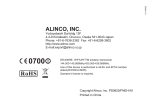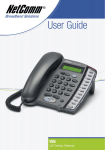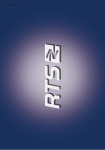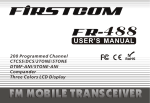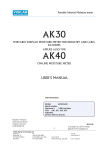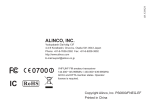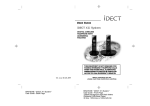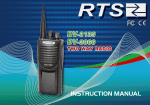Download CRT SS 6900 User manual
Transcript
USER MANUAL SAFETY INFORMATION FOR USER CRT transceiver is excellently designed with advanced technology. Please observe the following precautions to perform your obligation, prevent personal injury and ensure the safety of transceiver usage. 1.Keep the transceiver and accessories away from children. 2.Please do not try to open or modify the transceiver without permission, non-professionals process may also cause damage. 3.Please use assorted battery and charger to avoid damage. 4.Please use assorted antenna to ensure the communication distance. 5.Please do not expose the transceiver to long period of direct sunlight, nor place it close to heat appliances. 6.Please do not put the transceiver in excessively dusty or humid areas. 7.Do not use harsh chemicals, cleaning solvents to clean the transceiver. 8.Do not transmit without antenna. 9.When using this transceiver, we recommend transmitting for 1 minute then receiving for 4 minutes. Continuous transmitting for long time or working in high power will heat the back of the transceiver. Do not place the transceiver’s hot back close to any surface of plastic. 10.If any abnormal odor or smoke detected coming from the transceiver, turn off the power and take off the battery pack and its case. Then contact local CRT dealers. NOTICE All tips as above also apply to the standard parts of CRT transceiver. If any spare parts fail to work, please contact local CRT dealers in time. If users use spare parts from other suppliers instead of CRT, the safety and performance of the transceiver can't be guaranteed. THANK YOU FOR YOUR PURCHASE! Features include 199 memory channels, memory banks, UV-VV-UU modes, dual PTT(programmable), 51 groups CTCSS encode/decode, 1 group user-defined CTCSS encode/decode, 1024 groups DCS encode/ decode, plus 2Tone, 5Tone and DTMF encode/decode. Unique features include the ability to adjust squelch level on-the-ly, display both channel mode and frequency mode at the same time, skip interfering channels while scanning and choose single or dual PTT buttons. The frequency of named channels can be easily displayed and the scanning rate of channels is adjustable via software. Dual standby, dual display, dual receive channel, cross-band repeater functions, frequecny hopping functions(FHSS). TABLE OF CONTENTS CONTENS .................................................................................................................................................................................................... 01 Contents ................................................................................................................................................................................................... 01 STANDARD ACCESSORIES/ADDITIONAL ACCESSORIES ............................................................................................... 04 Standard Accessories.......................................................................................................................................................................... 04 Additional Accessories ........................................................................................................................................................................ 04 OPERATION MODE .....................................................................................................................................................................................05 BATTERY INFORMATION........................................................................................................................................................................ 06 How to Charge ........................................................................................................................................................................................ 06 Charging Prompt .................................................................................................................................................................................... 07 GETTING ACQUAINTED .......................................................................................................................................................................... 08 LCD Display ............................................................................................................................................................................................. 08 BASIC OPERATIONS ................................................................................................................................................................................. 10 Switch between Main band and Sub band ............................................................................................................................... 10 Switch between Channel mode and VFO mode .................................................................................................................... 10 Channel Adjusting ................................................................................................................................................................................. 10 Frequency Adjusting............................................................................................................................................................................. 10 Frequency Input by Keypad ............................................................................................................................................................. 11 Channel Input by Keypad .................................................................................................................................................................. 11 Squelch Off Momentary / Squelch Off ......................................................................................................................................... 11 Receiving ................................................................................................................................................................................................... 12 Transmitting .............................................................................................................................................................................................. 12 Emergency Alarm .................................................................................................................................................................................. 13 Side Key [PF1] function instruction............................................................................................................................................... 13 Side key [PF2] function instruction................................................................................................................................................ 14 Edit channel.............................................................................................................................................................................................. 14 01 TABLE OF CONTENTS Delete channel ........................................................................................................................................................................................ 14 Programming scan ................................................................................................................................................................................ 15 SHORTCUT OPERATIONS ..................................................................................................................................................................... 16 Turn On/ Off FM Radio........................................................................................................................................................................ 16 Add/Cancel Optional signal decode function ........................................................................................................................... 16 CTCSS/DCS Scan ................................................................................................................................................................................ 17 Offset Frequency Direction Setup ................................................................................................................................................. 17 Frequency/Channel Scan .................................................................................................................................................................. 18 Channel Scan Skip ............................................................................................................................................................................... 18 Frequency Reverse .............................................................................................................................................................................. 19 TX Power selection ............................................................................................................................................................................... 19 19 Talk Around function ................................................................................................................................................................................ DTMF code Transmit and Enquiry ................................................................................................................................................ 20 Keypad lock .............................................................................................................................................................................................. 20 Single-band Switching......................................................................................................................................................................... 21 CTCSS/DCS Encode and Decode................................................................................................................................................ 21 Cross-Band Repeater ........................ ................................................................................................................................................ 21 Function Menu Setup ........................ ...................................................................................................................................................... 22 Senior Function Operations ................................................................................................................................................................. 29 Display Mode Setup ............................................................................................................................................................................. 29 Resume Factory Default .................................................................................................................................................................... 29 Cloning Cable .......................................................................................................................................................................................... 30 Memory Bank (Version D ) ....................................................................................................................................................................... 32 Memory Bank Switch ........................................................................................................................................................................... 32 Memory Bank Exit ................................................................................................................................................................................. 32 Bank Linking............................................................................................................................................................................................. 33 02 TABLE OF CONTENTS Programming software starting (Takes Windows XP system for example) ........................................................... 34 TECHNICAL SPECIFICATION ............................................................................................................................................................... 35 ATTACHED CHART ..................................................................................................................................................................................... 37 CTCSS Frequency Chart ................................................................................................................................................................... 37 DCS Frequency Chart ....................................................................................................................................................................... 38 03 STANDARD ACCESSORIES/ADDITIONAL ACCESSORIES Standard Accessories Antenna Li-ion Battery Battery Charger AC Adaptor Belt Clip Additional Accessories USB Programming Cable Earphone Battery Pack for Car Charger Handheld Microphone 04 Car Charger Clone cable OPERATION MODE 1. How to choose a operation Mode: A. By programming software:In PC software's "General Setting" menu to choose "Display Mode", channel mode works as Professional transceiver, other two modes as Amateur transceiver. B. By manual setup:Please refer to "Display Mode" . 2. Amateur Mode: Under this mode, press key can switch between Channel mode and VFO mode. A. Frequency + Channel mode: When set display as "FREQ", the radio enters Frequency +Channel mode, new setting of channel operation and shortcut operation can be temporarily used by user. Once the radio is turned off or switched to another channel, the temporary setting will be erased and back to initial settings B. Channel+Name Tag Mode: When set display as "NAME", it enters Channel+Name Tag Mode. the LCD will display corresponding channel name when the current channel is edited with name. Otherwise, it will display frequency + channel. C. VFO Mode(Frequency mode): This mode shows only frequency on the display. Shortcut operation and Channel setting will be changed and stored as the latest value permanently. Once the radio is turned off or changed to new VFO frequency, the value is remained until next change. 3. Professional Mode: when set as CH mode, all radio functions shall be set by PC software, besides scan, DTMF encode, keypad lock. In CH mode, users can't return to amateur mode by menu function. 05 BATTERY INFORMATION How to Charge 1. Plug the AC adaptor into the AC outlet, then plug the cable of AC adaptor into the DC jack, the indicator lights orange for 1s and turns into GREEN---waits to charge. 2. Slide the battery or transceiver with battery into the Ac Input charger; make sure the battery terminals are in contact with the charging terminals. LED turns into twinkling RED---pre-charging begins. 3. Pre-charging for about 5 minutes, LED twinkles stop then charging begins. 4. It takes about 5.5 hours to fully charge the battery, when LED turns into GREEN— full charged. 5. Charging Process: Status LED Standby (self-examine orange lights 1second when power on) Pre-charging (pre-charging stage) Charging (charge in constant currency) Full charged (charge in constant voltage) Green light Red light twinkles for about 5 minutes RED light lightens for about 5.5 hours Green light 06 BATTERY INFORMATION 6. LED Indicator: STATUS LED Charge Full self-examine Trouble (No battery) Pre-charging normally Charged when power on Orange Red light twinkles Red twinkles Green Red Green (for 1 second) for 5 minutes for a long time NOTE: Trouble means battery heating, battery short-circuit or charger short-circuit. Charging Prompt 1. Self- examination: When charging, ORANGE light twinkles for 1 second and goes out. That means the charger has passed its self-examination and it can charge the battery normally. If the light remains orange or the red light twinkles, it means the charger can not pass its self-examination or charge the battery. 2. Trickle pre-charging: When the battery has been inserted into the charger and red light twinkles, which means the remnant voltage is low, the charger trickle charges the battery (pre-charging status), until the battery reaches a certain electric quantity, then the charger automatically turns to normal charging. If the red light stops twinkling, it means the remnant voltage meets a certain electric quantity, and the charger will charge the battery normally. NOTE:The time for Trickle pre-charging should not exceed 30 min. If after 30 min, the red indicator is still twinkling, it means it is unable to charge battery. Please kindly check battery and charger. 07 GETTING ACQUAINTED LCD Display On LCD display screen, you will see various icons which stand for the selected functions and sometimes you may forget the meaning of them. Here you will find the following table extremely useful. Frequency Reverse Offset Frequency DCS Optional Signaling CTCSS VOX Function Scan Skip Narrow band Battery Capacity FUNC Icon Function Menu Number, Channel Number The arrow points to main channel FM radio FM Channel Number channel Number Keypad Lock TX Power Busy Channel NOTE: Battery capacity indicator(full) Battery capacity remnant No power, replace battery pack or charge battery Real time display receiving signal strength/Power Indicator 08 GETTING ACQUAINTED 1 Antenna 2 Selector Knob 3 Power/Volume switch 1 4 Emergency Aarm 5 TX/RX indicator 6 LCD display 7 Keypad 2 3 5 4 8 PTT key 9 PF1 key 8 SP 9 MIC 6 10 13 BAND MSK DCIN 12 11 10 PF2 key 11 J 12 Car charging port 13 Single-band Switching 7 14 14 Memory Bank 09 BASIC OPERATIONS Switch between Main band and Sub band Under standby state, press key to switch between Main band and Sub band. Arrow indicates the Main band. Switch between Channel mode and VFO mode Under standby state, press mode (VFO). key to set main band as Channel mode or frequency Channel Adjusting With transceiver in Channel mode or FM radio channel mode, rotate channel switch to adjust channel. Rotate channel switch clockwise to increase channel number, anticlockwise to decrease channel number. NOTE: In transceiver mode, arrow directs the main band channel. Rotating channel switch will step through only programmed (saved) channels. Unsaved channels will be skipped. Frequency Adjusting With transceiver in VFO mode or FM radio frequency mode, rotate channel switch to adjust frequency. Rotate channel switch clockwise to increase frequency, anticlockwise to decrease frequency. Frequency change depends on chosen frequency step. 10 BASIC OPERATIONS NOTE: Channel step:2.5K, 5K, 6.25K, 10K, 12.5K, 20K, 25K, 30K and 50KHz in total 9 for optional. FM radio step frequency is 50K. Frequency Input by Keypad Under frequency mode or FM radio frequency mode, you can directly enter frequency through keypad. 1. When your transceiver is under Channel mode, press key to switch into VFO. NOTE: When the transceiver is under Channel mode, it shows current channel number on the right of main frequency. 2. Enter the desired frequency by keypad. NOTE: The frequency input of main channel or FM radio is relevant to the stepping and transceiver frequency range. If frequency setup is beyond range or not matching with step size, the input is unavailable. Under the FM radio mode, the frequency step size input by numeric keys is 100k. Channel Input by Keypad Under channel mode of transceiver or FM radio, you can switch to desired channel by entering three numbers (000-199). If the entered channel is not a saved channel, the transceiver will emit beep to prompt wrong input and return to current channel. For example, entering 001 is channel 1, 030 is channel 30, 125 is channel 125. Squelch Off Momentary / Squelch Off Side key [PF2] can be setup for Squelch off Momentary or Squelch off function by programming software. 11 BASIC OPERATIONS 1. Squelch off: Press [PF2] key, squelch circuit is not mute, back-ground noise can be heard. Press [PF2] key again, squelch circuit is mute. 2. Squelch off Momentary: Press and hold [PF2] key, squelch circuit is not mute, back-ground noise can be heard. Release [PF2] key, squelch circuit is mute. NOTE: The above functions are only available after [PF2] key setup in programming software. When in channel mode, opening squelch will show the frequency of the channel. Receiving When your transceiver is called by other party, green or blue LED light will be on, LCD backlight will be on at the same time, and the arrow icon will flash, you can hear the calling. NOTE: You may not receive the calling when your transceiver is set at high squelch level. If current channel is programmed with decode signal, only the same signaling call can be heard. Transmitting According to [PF2] key setup in programming software, hold [PF2] key to monitor the channel to ensure it is not busy, press PTT key and talk to speaker. Please keep the distance between mouth and speaker to be 2.5-5CM, speak in normal tone to get the best acoustic fidelity. NOTE: When press and hold PTT key, transceiver is transmitting if the red LED light is on, release PTT key to receive calls. 12 BASIC OPERATIONS Emergency Alarm Under standby state, press and hold [PF1] key (when programmed for ALARM function) or press the Emer -gency Alarm keyuntil LCD displays "ALARM", Emergency alarm function is started. This transceiver has 4 Alarm modes that can be setup in programming software. Power off transceiver to exit Alarm. Side Key [PF1] function instruction [PF1] key can be setup in for below functions: 1. VOLT: Battery capacity inquiry: Under standby, press [PF1] key, LCD displays current battery capacity, press this key again to exit. 2. CALL: Transmit the prestored DTMF/5TONE Encode signal in channel. 3. FHSS(Version D): Frequency hopping function. Press [PF1] key, turn on frequency hopping function, LCD display "FHSS", transceiver will communicate in pre-set hopping frequency range. Note: Receiver and Sender must have same hopping frequency, and must setup MSK decode signalling. 4. ALARM: Long pressing [PF1] key, LCD display "ALARM", transceiver will enable the preset alarm function. 5. SUBPTT: Press [PF1] key, transceiver will transmit on sub-band frequency. 6. Transmit tone pulse frequency: Press and hold PTT key, then press [PF1] key to transmit selected tone pulse frequency. NOTE: The tone pulse frequency can be set to 1750Hz, 1450Hz, 1000Hz or 2100Hz in programming software. 13 BASIC OPERATIONS Side key [PF2] function instruction 1. Squelch off: Press [PF2] key, squelch circuit is not mute, back-ground noise can be heard. Press [PF2] key again, squelch circuit is mute. 2. Squelch off Momentary: Press and hold [PF2] key, squelch circuit is not mute, back-ground noise can be heard. Release [PF2] key, squelch circuit is mute. 3. Transmit DTMF/5TONE/2TONE signaling: Press and hold [PTT] key, then press [PF2] key to transmit selected DTMF/5TONE/2TONE signaling. 4. Press and hold [PF2] key to turn on transceiver, until transceiver emits "DU" beep, transceiver enter into general functions setup. Edit channel 1. Under frequency mode (VFO), enter desired frequency and settings, press key, the top left corner of LCD displays " " icon, press key to switch into channel mode, channel number flashes. 2. Rotate channel switch to select desired editing channel number. 3. Press key, the top left corner of LCD displays " " icon, press and hold key until transceiver emits "DUDU" beep, channel is stored successfully. Delete channel 1. Under standby state, press key, the top left corner of LCD displays " switch into channel mode, channel number flashes. 14 " icon, press key to BASIC OPERATIONS 2. Rotate channel switch to select desired deleting channel number. 3. Press key, the top left corner of LCD displays " " icon, press and hold key until transceiver emits "DUDU" beep and clear up frequency information of current channel, deletion is successful. NOTE: This process can be applied for deleting FM radio channels. Programming scan Setup the frequency of L1 channel, U1 channel, L2 channel and U2 channel will realize VFO frequency scanning border limited. L1 & L2 is starting frequency, U1 & U2 is end frequency. When VFO frequency between L1~ U1 or L2 ~ U2, transceiver will scan frequencies between L1 ~ U1 or L2 ~ U2. When VFO frequency is lower than L1 or L2, transceiver will scan frequencies higher than L1 or L2. When VFO frequency is higher than U1 or U2, transceiver will scan frequencies higher than U1 or U2. 1. In VFO mode, enter desired frequency and relative setup, press key, the top left corner of LCD displays " " icon, then press key switch into channel mode, channel number flashes 2. Rotate channel switch to choose desired channel number. key, the top left corner of LCD displays " " icon, then press key until transceiver emits 3. Press "DUDU" beep, channels are saved successfully. NOTE: To make this setup, L1 and U1 must in same frequency band. L2 and U2 must in same band. 15 SHORTCUT OPERATIONS Turn On/ Off FM Radio This radio has FM/AM/SW/LW total 4 FM radio bands. Press key then press key to turn on FM radio, later press key then press key to switch between FM/AM/SW/LW band, press key will mute /un-mute FM radio. FM: 64~108MHz(RX) (100 memory channels CH00~CH99 AM: 118~136MHz(RX) (100 memory channels CH00~CH99 SW: 2.3~29.99MHz(RX) LW: 0.52~1.71MHz(RX) Note:AM/SW/LW require special antenna. When AM is on, the downside RX channel is occupied. Add/Cancel Optional signal decode function Under standby state, press key, the top left corner of LCD displays " " icon, press key. 1. LCD display "DTMF" and " T " icon, DTMF signal add in current channel. 2. Repeat above operation, LCD display "5TONE" and " T " icon, 5TONE signal add in current channel. 3. Repeat above operation, LCD display "2TONE" and " T " icon, 2TONE signal add in current channel. 4. Repeat above operation, LCD display "MSK" and " T " icon, MSK signal add in current channel. 5. Repeat above operation, LCD display "OFF", the " T " icon disappear, no optional signal in current channel. NOTE: When this function is on, user must setup No.7 menu to be TONE option, then DTMF/5TONE/2TONE/ MSK can be used. 16 SHORTCUT OPERATIONS CTCSS/DCS Scan Press key, the top left corner of LCD displays " " icon, press key to enter into CTCSS/DCS scan. Under this state, rotate channel switch to change scan direction. When scan the matching CTCSS/DCS signaling, it will stay 5seconds and then go on scanning. Press any other keys except , , MSK key to exit. NOTE: This function is invalid when transceiver works in professional mode or the arrow directed channel no setting CTCSS/DCS signaling. In current channel, if signaling set as CTCSS, it will scan CTCSS, if sets as DCS, it will scan DCS. Offset Frequency Direction Setup Under standby state, press key, the top left corner of LCD displays " " icon, key to choose offset frequency direction. There are 3 options, Positive press offset, Minus offset, shut off offset. 1. (+) Positive offset: Indicates TX frequency is higher than RX frequency. When enable reverse function, the RX frequency is higher than TX frequency. 2. (-) Minus offset: Indicates TX frequency is lower than RX frequency. When enable reverse function, the RX frequency is lower than TX frequency. 3. None: Indicates shut offset off. Under frequency mode (VFO) or channel mode, press key then press key to choose positive offset direction(+), minus offset direction (-) , shut offset off one by one (Please refer to offset frequency setup). NOTE: This function is unavailable in professional transceiver mode. 17 SHORTCUT OPERATIONS Frequency/Channel Scan Under corresponding mode, press key, the top left corner of LCD displays " " icon, then press key to start frequency scan or channel scan. 1. Frequency Scan Under VFO mode, frequency scan is available. This function is used for monitoring signal of various communication frequency by transceiver ‘step’ setup, press numeric key or key to exit. 2. Channel Scan Under channel mode, this function is used for monitoring signal of each channel in this mode. Press numeric key or key to exit. NOTE: ▼ Frequency scan is of all bands scan, it scans upwards as your STEPPING setting. ▼ In channel scan, the skipped channel is not in the line of scanning. Scan upwards as per channel no. (please refer to channel scan skip). ▼ Frequency/channel scan can change scan direction by rotating channel switch, when find a matching carrier wave and signaling, the transceiver will stay 5 seconds then go on scanning. (Please refer to scan setup) If turn off radio in scan mode, when re-power on, radio will resume scanning automatically. Channel Scan Skip Under channel mode, press key, the top left corner of LCD displays " " icon, then press set current arrow directed channel as Channel scan skip. Repeat above operation to cancel channel scan skip. 1. LCD displayed " S " means the current channel will not be scanned. 2. " S " icon disappeared means the current channel will be scanned. 18 key to SHORTCUT OPERATIONS Frequency Reverse Under standby state, press key, the top left corner of LCD displays " " icon, then press key to set arrow directed channel as frequency reverse, repeat above operation to turn off frequency reverse. 1. When LCD displays "R" icon, it means current arrow directed channel open the frequency reverse function, the TX frequency and RX frequency is interchanged, if CTCSS/DCS signaling is set, it will also interchange. 2. When "R" icon disappears, it means reverse function is close. TX Power selection Under standby state, press key, the top left corner of LCD displays " " icon, then press key to choose High/Low power for current arrow directed channel. 1. When LCD displays "L" icon, it means low power is chosen. 2. When LCD displays "H" icon, it means high power is chosen. Talk Around function Under standby state, press key, the top left corner of LCD displays " " icon, then press , the arrow directed channel will enable talk around, repeat the above operation to close talk around. 1. TX=RX: Enable talk around, current channel transmit at RX frequency, if CTCSS/ DCS signaling is set, it will interchange decoding CTCSS/DCS as encoding. 2. OFF: Close talk around. 19 SHORTCUT OPERATIONS DTMF code Transmit and Enquiry 1. Press key, the LCD key, the LCD displays " " icon, then press displays DTMF data and group number (total 16groups) of current group. 2. Rotate channel switch to choose desired group and DTMF data, press PTT key to transmit selected DTMF signaling. If current group not edit DTMF data, LCD displays "EMPTY". 3. When current group displays "EMPTY", press key, the top left corner of LCD displays " " icon, press and hold key until transceiver emits "DU" beep, transceiver enters into DTMF edit state, LCD displays "___________", now you can enter desired DTMF data by keypad. 4. When finished editing, press side key [PF2] to save DTMF signaling. Keypad lock Keypad lock operation can be done by software programming or radio keypad. 1) Radio keypad operation key, the top left corner of LCD displays " " icon, then press and hold Press MSK key until transceiver emits "DU" beep, LCD displays " " icon, keypad is locked. Repeat above operation, " " icon disappears, keypad is unlocked. 2) Software Programming ON: Keypad lock option tick on. OFF: Keypad lock option tick off. Note: When keypad lock is turned on by software programming, the keypad lock operation is invalid. 20 SHORTCUT OPERATIONS Single-band Switching To reduce interference from the sub-band when only the main-band is needed. You can use the single-band switching function to turn off the sub-band quickly. will cycle LCD display to show Main + Sub-Band / Sub-Band Only / Main-Band Continuous pressing of Only. CTCSS/DCS encode and decode 1. Press key then press [PF2] to enter into setup. 2. Press [PF2] key to choose CTCSS, DCS or OFF, when choose DCS, press or negative code. 3. Rotate Channel selector to choose desired CTCSS/DCS encode and decode. MSK 4. Press key or key to confirm and exit. key to select positive Cross-Band Repeater Set main-band and sub-band to desired VHF & UHF frequencies, then open cross band repeater function. to enter into function menu together and power on 1. In power off radio, press [PF1] and then press radio until LCD shows "RPT ON". LCD shows " " in LCD top left corner. 2. Repeat above operation, "RPT OFF" is turn off cross band repeater function. 21 FUNCTION MENU SETUP Menu 1-17 of this transceiver are channel operations. Channel operations temporarily changed the functions of current channel. When power off or channel has been changed, the relevant setup will be erased. Only under VFO mode, the channel operations will be saved until next change. Menu 18-50 are background operations (menu 20-29 are memory bank setup), it is valid for all channels, the relevant setup will be saved until next change. The operating methods are as follows: key, the top left corner of LCD displays " 1. Press 2. Press / key to choose desired function. 3. Rotate channel switch to choose desired setting. MSK key or key to confirm and exit. 4. Press " icon, then press key to ente menu. key to choose CTCSS, DCS or off, when Note: When setup CTCSS/DCS encode and decode, press choose DCS, press key to switch positive and negative code. When edit the name, press key to shift the cursor down, press key to shift the cursor up. 22 FUNCTION MENU SETUP Menu LCD Display Function No. 1 T-CDC CTCSS/DCS Encode 2 R-CDC CTCSS/DCS Decode 3 RT-CDC CTCSS/DCS Encode/Decode Synchronous 4 2T-ENC 5 5T-ENC 6 2T-DEC 7 MSKENC 8 TONDEC 2 TO N E E n c o d e list 5 TO N E E n c o d e list 2 TO N E D e c o d e list MSK Encode list Optional signaling setup Options Description OFF 62.5HZ-254.1Hz+Self defined 000N-777I OFF 62.5HZ-254.1Hz+Self defined 000N-777I OFF 62.5HZ-254.1Hz+Self defined 000N-777I No CTCSS/DCS Encode 51 groups fixed CTCSS encode+1 group selfdefined encode 1024 groups DCS Encode No CTCSS/DCS Decode 51 groups fixed CTCSS decode+1 group selfdefined decode 1024 groups DCS decode No CTCSS/DCS encode/decode 51 groups fixed CTCSS encode/decode + 1 group self-defined CTCSS encode/decode 1024 group DCS encode/decode CALL00-31 32 groups 2Tone encode list CALL00-31 32 groups 5Tone encode list DEC 00-31 32 groups 2Tone decode list CALL00-31 32 groups MSK encode list Current optional signal is DTMF/5TONE/2TONE/ DTMF/5TONE/2TONE/MSK MSK 23 FUNCTION MENU SETUP Menu LCD Display Function No. 9 SIGNAL Squelch mode setup Options Description SQ When current channel received matching RF signals, transceiver can hear the talking from the other party. CTCSS/DCS When current channel received matching RF signals and matching CTCSS/DCS signaling, transceiver can hear the talking from the other party. TONE When current channel received matching RF signals and matching optional signaling, transceiver can hear the talking from the other party. When current channel received matching RF signals + matching optional signaling + matching CTCSS/DCS signaling, transceiver can hear the talking from the other party. When current channel received matching RF signals, or matching optional signaling, or matching CTCSS/DCS signaling, transceiver can hear the talking from the other party. CT&TO CT/TO 10 STEP 11 W/N 12 REV Frequency step size setup Wide / Narrow Band Setup Frequency Reverse 2.5K-50K 9 options in total 25K/12.5K Wide band/Narrow band ON Turn on Frequency reverse function, TX and RX frequency of current channel will be interchanged. OFF Close Frequency reverse function. 24 FUNCTION MENU SETUP Menu LCD Display Function No. 13 Options Description Turn on Talk Around function, current channel will transmit at RX frequency, if CTCSS/DCS signaling is set, it will interchange decoding CTCSS/DCS as encoding. Close Talk Around function. Note: It is available to setup in Programming software. RX:UHF, TX:VHF or RX:VHF, TX:UHF In channel name display mode, will display the edited channel name. Carrier wave lock, transmitting is prohibited when received matching carrier wave. Signaling lock, transmitting is prohibited when received matching carrier but with mismatching CTCSS/DCS. Close BCLO function. TX=RX TALKAR Talk Around 14 OFFSET Offset Frequency setup 0-70MHz 15 NAME Editing Channel name a-Z, 0-9 16 RPLOCK Busy Channel Lockout REPEAT 17 TX TX OFF ON/OFF TX function is enabled in current channel. 18 BAK -- Group Selection 19 BALK Group linking 20 BLK 1 Link Group 1 21 BLK 2 Link Group 2 22 BLK 3 Link Group 3 23 BLK 4 Link Group 4 0-9 OFF ON OFF/ON OFF/ON OFF/ON OFF/ON Display current working group Turn off group linking, menu 20-29 is hide. Turn on group linking, menu 20-29 display. Add or remove the group 1 in group linking Add or remove the group 2 in group linking Add or remove the group 3 in group linking Add or remove the group 4 in group linking OFF BUSY OFF 25 FUNCTION MENU SETUP Menu No. 24 25 26 27 28 29 30 31 32 LCD Display Function Options Description BLK 5 Link Group 5 OFF/ON Add or remove the group 5 in group linking BLK 6 Link Group 6 OFF/ON Add or remove the group 6 in group linking BLK 7 Link Group 7 OFF/ON Add or remove the group 7 in group linking BLK 8 Link Group 8 OFF/ON Add or remove the group 8 in group linking BLK 9 Link Group 9 OFF/ON Add or remove the group 9 in group linking BLK 0 Link Group 0 OFF/ON Add or remove the group 0 in group linking PF1 BAND DSPSUB VOLT Displays current battery capacity. CALL Call function FHSS Frequency hopping ALARM Emergency alarm function SUBPTT Sub band PTT OFF No function ON/OFF Turn on/off band limit function Sub band display setup FREQ Display sub band frequency or channel VOLT Display current battery voltage OFF Sub band display is disabled ON/OFF Turn on/off keypad voice prompt function OFF Turn off time-out timer Total 27 levels for optional, each level step 10seconds. Self define PF1 key function VFO band limit 33 BEEP Keypad Voice prompt setup 34 TOT Time-Out-Timer 10-270S 26 FUNCTION MENU SETUP Menu LCD Display Function No. Voice Operated 35 VOX Transmission (VOX) Setup 36 VDELAY VOX Delay Setup 37 APO 38 DTMF 39 SQL 40 41 SCAN SPEED Automatic Power Off Setup DTMF Transmitting Time Squelch level Setup Scan Dwell Time Setup Scan Speed Setup Options Description OFF Turn off VOX function 1--10 Total 10 VOX levels for optional 0.5S-3S Total 27 levels for optional, each interval is 0.1S OFF Disable the Automatic power off function 30MIN-2HOUR 30minutes ~ 2hours: Total 3 levels for optional. Total 5 kinds of DTMF transmitting time for optional. 10 levels of squelch in total for optional, "00" is minimum setup value (normally open) 50MS-500MS 00-09 When scanning matched signal, transceiver will stop scanning for 5-15seconds then resume. 5ST-15ST When scanning matched signal, transceiver will stop scanning, 2seconds after signal disappeared, then resume. Fast scan speed 2SP QUICK NORMAL Normal scan speed When finished function setting or enter into function menu, icon disappeared. When finished function setting or enter into function menu, icon stay 1-3seconds then disappeared. FUNCT 42 FTIME Function Icon Stay Time 1SEC-3SEC Function icon is always display, only when pressing function key again, the icon will disappear. ALWAYS 27 FUNCTION MENU SETUP Menu LCD Display Function No. 43 Options Description ON/OFF Always on/off AUTO Backlight will automatic closed after a period LIGHT LCD Backlight 44 COLOR LCD Backlight Color BLUE/ORG/PUR Blue/Orange/Purple 45 ID Self ID inquiry 001/12345 LCD displays radio self ID, DTMF ID is 3 digits, 5TONE ID is 5 digits. 46 TBST Tone Pulse Frequency Selection 1750Hz/2100Hz /1450Hz/ 1000Hz Tone plus frequency is 1750Hz/2100Hz/ 1450Hz/1000Hz Turn off battery save function SAVE Battery Save Setup OFF 47 1:2-1:8 Battery save time is 1:2-1:8 AUTO Battery save ratio is adjusting automatically. 48 RADIO FM radio ON/OFF Allow/Prohibit using FM radio. 49 SUBVOL Sub-Radio Volume 1--8 Setting 50 MUTE RPT mute setup Adjust main band receive, at the same time Sub band output volume In UV or VU mode, mute the RX sub band when main band is TX. Sub band is not mute when main band is TX. ON OFF 28 SENIOR FUNCTION OPERATIONS Display Mode Setup There are three kinds of display modes for optional. 1. Press [PF2] key to turn on radio, hold [PF2] key until transceiver emits beep. 2. Press / key to choose No.01 function item, it shows "DSP" on LCD. 3. Rotate channel switch to choose desired setup. FREQ: Frequency+Channel mode, transceiver displays current channel name + frequency, press key to switch into VFO mode. CH: Channel mode, 1~24 items of function menu will hide automatically, user can only operate some functions. It is unable to switch into VFO by pressing key. This model can be used for Amateur mode. NAME: Channel+Name Tag mode, transceiver displays current channel number key to switch into VFO mode. +channel name, press 4. Press key or MSK key to confirm and exit. Resume Factory Default You can make all the settings of transceiver return to the factory default settings when transceiver can not work normally because of wrong operation or error setup. 1. Press [PF2] key to turn on radio, hold [PF2] key until transceiver emits beep. / key to choose No.02 function item, it shows "RESTOR" on LCD. 2. Press 3. Rotate channel switch to choose desired setup. 29 SENIOR FUNCTION OPERATIONS OFF: No operations. FACT: Resume all items to factory default, including channel and background settings. INIT: Resume background settings to factory default, channel operations are keeping. 4. Press 5. Press key to exit current selection. key to confirm current selection. MSK Cloning Cable This feature will copy the programmed data and parameters from the master unit to slave units. It copies the parameters and memory program settings. Connection: Use optional CP04 cloning cable, connect Read/write frequency port on both master and slave, setting and programing as the requirement below. BAND 30 MSK BAND MSK 42 SENIOR FUNCTION OPERATIONS [Settings: Master side] 1. Press the [PF1] side key to Power on, the display shows "CLONE", the master unit enters into copy mode . 2. Press [PF1] key, the display appears "CLONE XX" XX stands for the data amount being cloned. 3. When the data transfer is completed, slave unit restarts, the master unit display appears "CLONE 04". 4. Master unit remain copy mode state to prepare for the next copy, if reboot the master means exit copy mode to return to normal mode. [Settings: Slave side] 1. In the standby mode, when the slave receives the data, the display shows "CLONE XX" XX stands for the data being cloned. 2. When data reception is complete, the slave unit returns to normal mode and restart automatically. 3. Turn off the slave's power, remove the cable, insert another slave which you want to copy. If the data is not successfully transmitted, turn off the master and slave, check if the cable connections are correct, and then repeat the whole process again. 31 MEMORY BANK 10 memory banks 0-9 are available, bank 0 includes all edited channels. Bank 1-9 can be assigned maximum 32 channels, a channel can be assigned to more groups by software or keypad. Assign channel to memory bank: 1. In Memory channel mode, choose a memory channel, press SMK key, bank number show in the channel number position as "-X" twinkling. 2. Turn Channel selector to choose desired memory bank, press SMK key, the memory channel will be assigned to the bank. 3. If the bank already has 32 channels, the new assigned channel will replace the last channel in bank. Memory Bank Switch key then press In Channel mode, press SMK key twice to enter memory bank mode, press key to enter into function menu. / key to choose menu 18, LCD displays“ BAK - -” 1. Press 2. Turn Channel switch to choose bank 0--9, press SMK key confirm 3. Rotate the channel switch clockwise to enter into desired memory bank. Note: When the bank linking is on, if no channel in the selected bank, radio will enter into the next linking bank. When the bank linking is off, if no channel in the selected bank, current channel will be assigned to this bank. Memory Bank Exit When transceiver in memory bank mode, press SMK 32 key twice to exit and return to channel mode. MEMORY BANK Bank linking 1. In channel mode, press SMK key twice to enter into memory bank mode, press key to enter into function menu. / key to choose menu 19, LCD show " BALK". 2. Press ON: Turn on Bank linking. The following menus allow adding or deleting banks. Menu No. Menu20 Menu21 Menu22 Menu23 Menu24 Menu25 Menu26 Menu27 Menu28 Menu29 LCD display Funtion Option BLK1 BLK2 BLK3 BLK4 BLK5 BLK6 BLK7 BLK8 BLK9 BLK0 Link Group 1 Link Group 2 Link Group 3 Link Group 4 Link Group 5 Link Group 6 Link Group 7 Link Group 8 Link Group 9 Link Group 10 OFF/ON OFF/ON OFF/ON OFF/ON OFF/ON OFF/ON OFF/ON OFF/ON OFF/ON OFF/ON key then press OFF: Turn off Bank linking, hide menu 20-29. When bank linking is on, one or more banks can be added into scan list. In memory bank mode, enable the scanning function, transceiver will scan the channels in current bank. During scanning, long pressing key 0-9 will add or delete the corresponding memory bank. 33 TECHNICAL SPECIFICATION General VHF:144~146MHz UHF:430~440MHz FM:64~108MHz(RX) Frequency Range AM: 118~136M Hz(RX) SW: 2.3~29.99MHz(RX) LW: 0.52~1.71MHz(RX) Channel Capacity Channel Spacing Phase-locked Step Operation Voltage Battery Life Frequency Stability Operation Temperature Size Weight 199 channels 25KHz (wide band) 12.5KHz (narrow band) 0.1KHz 7.4V DC ±20% More than 12 Hours(2200mAh), by 5-5-90 working cycle ±2.5ppm -20℃~ +55℃ 112 x 61x 35 mm ( with battery ) 285g (with battery) 35 TECHNICAL SPECIFICATION Receiving Part Sensitivity (12dB SINAD) Adjacent Channel Selecitvity Intermodulation Spurious Rejection Hum & Noise Audio Distortion Audio Power Output Power Output Modulation Adjacent Channel Power Hum & Noise Spurious Emission Audio Distortion Wide band Narrow band ≤0.25μV ≤0.35μV ≥65dB ≥60dB ≥70dB ≥45dB ≥60dB ≥60dB ≥70dB ≥40dB ≤5% 1000mW/10% Transimitting Part Wide band VHF:6W/1W Narrow band UHF:5W/1W 16KΦF3E ≥65dB ≥40dB ≤-36dB 11KΦF3E ≥60dB ≥40dB ≤-36dB ≤5% 36 ATTACHED CHART CTCSS Frequency Chart 1 2 3 4 5 6 7 8 9 10 11 62.5 67.0 69.3 71.9 74.4 77.0 79.7 82.5 85.4 88.5 91.5 12 13 14 15 16 17 18 19 20 21 22 94.8 97.4 100.0 103.5 107.2 110.9 114.8 118.8 123.0 127.3 131.8 23 24 25 26 27 28 29 30 31 32 33 136.5 141.3 146.2 151.4 156.7 159.8 162.2 165.5 167.9 171.3 173.8 34 35 36 37 38 39 40 41 42 43 44 37 177.3 179.9 183.5 186.2 189.9 192.8 196.6 199.5 203.5 206.5 210.7 45 46 47 48 49 50 51 52 218.1 225.7 229.1 233.6 241.8 250.3 254.1 user-defined ATTACHED CHART 1024 groups DCS frequency chart 000 010 020 030 040 050 060 070 100 110 120 130 140 150 160 170 200 210 220 230 240 001 011 021 031 041 051 061 071 101 111 121 131 141 151 161 171 201 211 221 231 241 002 012 022 032 042 052 062 072 102 112 122 132 142 152 162 172 202 212 222 232 242 003 013 023 033 043 053 063 073 103 113 123 133 143 153 163 173 203 213 223 233 243 004 014 024 034 044 054 064 074 104 114 124 134 144 154 164 174 204 214 224 234 244 005 015 025 035 045 055 065 075 105 115 125 135 145 155 165 175 205 215 225 235 245 38 006 016 026 036 046 056 066 076 106 116 126 136 146 156 166 176 206 216 226 236 246 007 017 027 037 047 057 067 077 107 117 127 137 147 157 167 177 207 217 227 237 247 ATTACHED CHART 250 260 270 300 310 320 330 340 350 360 370 400 410 420 430 440 450 460 470 500 510 520 530 251 261 271 301 311 321 331 341 351 361 371 401 411 421 431 441 451 461 471 501 511 521 531 252 262 272 302 312 322 332 342 352 362 372 402 412 422 432 442 452 462 472 502 512 522 532 253 263 273 303 313 323 333 343 353 363 373 403 413 423 433 443 453 463 473 503 513 523 533 254 264 274 304 314 324 334 344 354 364 374 404 414 424 434 444 454 464 474 504 514 524 534 255 265 275 305 315 325 335 345 355 365 375 405 415 425 435 445 455 465 475 505 515 525 535 39 256 266 276 306 316 326 336 346 356 366 376 406 416 426 436 446 456 466 476 506 516 526 536 257 267 277 307 317 327 337 347 357 367 377 407 417 427 437 447 457 467 477 507 517 527 537 ATTACHED CHART 540 550 560 570 600 610 620 630 640 650 660 670 700 710 720 730 740 750 760 770 541 551 561 571 601 611 621 631 641 651 661 671 701 711 721 731 741 751 761 771 542 552 562 572 602 612 622 632 642 652 662 672 702 712 722 732 742 752 762 772 543 553 563 573 603 613 623 633 643 653 663 673 703 713 723 733 743 753 763 773 544 554 564 574 604 614 624 634 644 654 664 674 704 714 724 734 744 754 764 774 545 555 565 575 605 615 625 635 645 655 665 675 705 715 725 735 745 755 765 775 546 556 566 576 606 616 626 636 646 656 666 676 706 716 726 736 746 756 766 776 547 557 567 577 607 617 627 637 647 657 667 677 707 717 727 737 747 757 767 777 NOTE: N stands for positive code. I stands for inverted code. 1024 groups of DCS in total. 40 A1.141128




















































